Change in Quality of Life in Patients with Advanced Rectal Cancer Between 2010 and 2022
Abstract
1. Introduction
2. Materials and Methods
3. Results
3.1. Cohort of 516 Rectal Cancer Patients
3.2. Symptom and Functional Score Distribution of Quality of Life
3.3. Clear Changes in Quality of Life over 13 Years
3.4. Quality-of-Life Scores for Which There Was Hardly Any Change over 13 Years
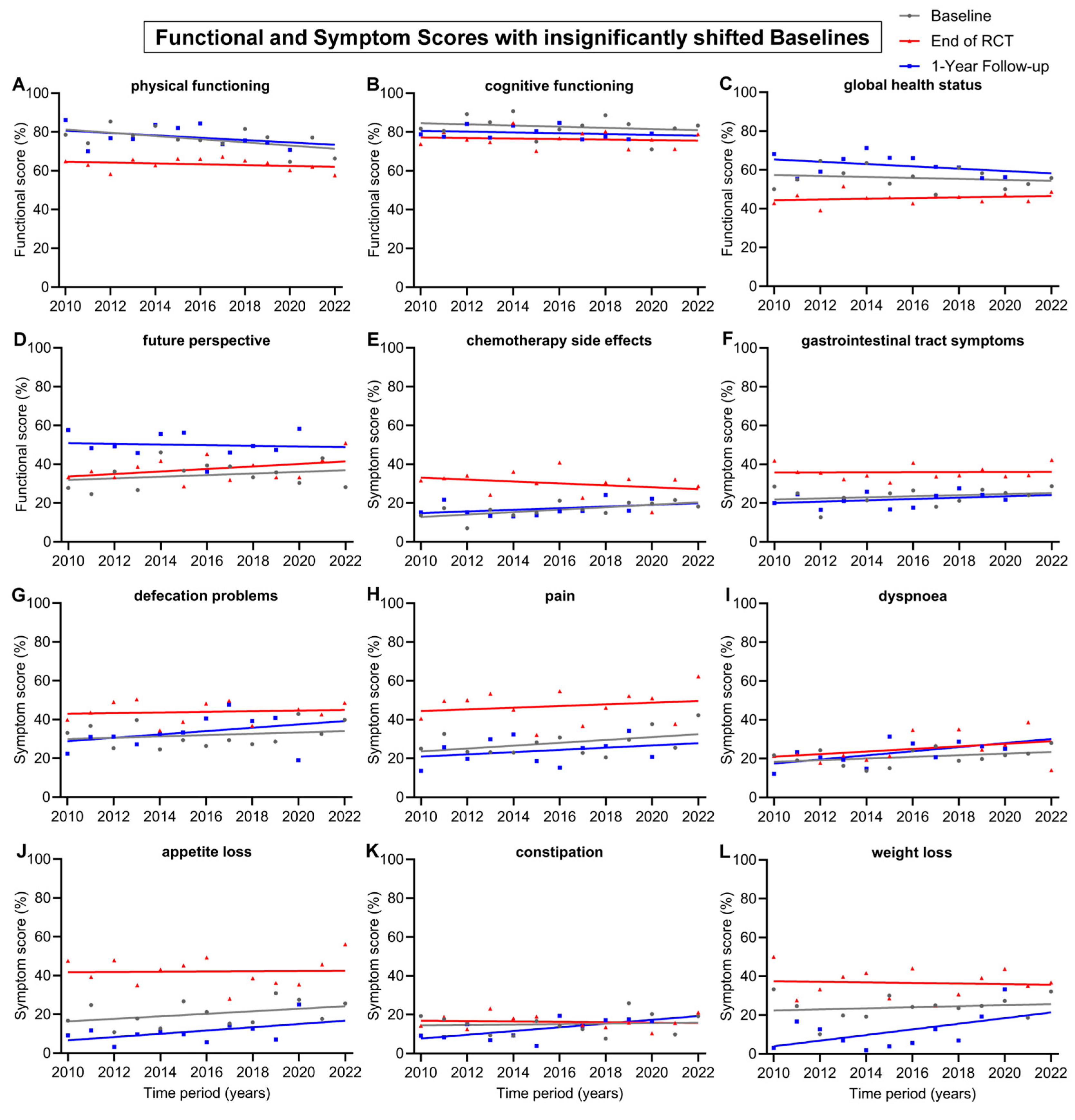
3.5. Is There a Deterioration in Clinical Characteristics over Time in the Patient Cohort?
3.6. Does the Radiochemotherapy Delivered to the Patient Cohort Change over Time?
4. Discussion
4.1. The Changes in QOL Scores After the RCT and 1 Year After the End of Treatment
4.2. The Deterioration of Baseline Quality of Life with Time
| General German Population | Rectal Cancer Patients | RC-gGp | 1-Year Follow-Up | ||||||||
|---|---|---|---|---|---|---|---|---|---|---|---|
| 1998 [21] | 2012 [25] | 2017 [24] | Change 2012–2017 | 2012 (This Study) | 2017 (This Study) | Change 2012–2017 | 2012 | 2017 | Mean RC (This Study) | Mean RC-2017 gGp | |
| Functional scores | |||||||||||
| Physical | 90.5 | 92.7 | 82.8 | −9.9 | 85.4 | 73.9 | −11.5 | −7.3 | −8.9 | 77.6 | −5.2 |
| Role | 88.5 | 90.8 | 80.8 | −10 | 75.7 | 52.1 | −23.6 | −15.1 | −28.7 | 61.0 | −19.8 |
| Emotional | 79.2 | 83.7 | 73.9 | −9.8 | 68.7 | 62.2 | −6.5 | −15.0 | −11.7 | 69.5 | −4.4 |
| Cognitive | 91.5 | 93.8 | 83.9 | −9.9 | 89.2 | 83.3 | −5.9 | −4.6 | −0.6 | 79.6 | −4.3 |
| Social | 91.5 | 93.6 | 84.8 | −8.8 | 69.8 | 46.5 | −23.3 | −23.8 | −38.3 | 60.2 | −24.6 |
| Global health status | 71.5 | 75.9 | 67.0 | −8.9 | 64.6 | 47.2 | −17.4 | −11.3 | −19.8 | 62.4 | −4.6 |
| Symptom scores | |||||||||||
| Fatigue | 16.6 | 15.0 | 31.5 | −16.5 | 29.4 | 40.7 | −11.3 | −14.4 | −9.2 | 32.4 | −0.9 |
| Nausea/vomiting | 2.7 | 2.1 | 6.0 | −3.9 | 2.3 | 9.7 | −7.4 | −0.2 | −3.7 | 6.2 | −0.2 |
| Pain | 14.6 | 15.8 | 27.6 | −11.8 | 23.4 | 22.9 | +0.5 | −7.6 | +4.7 | 23.9 | +3.7 |
| Dyspnoea | 7.8 | 6.9 | 18.7 | −11.8 | 24.3 | 26.4 | −2.1 | −17.4 | −7.7 | 22.7 | −4.0 |
| Insomnia | 15.5 | 11.7 | 27.6 | −15.9 | 35.1 | 31.9 | +3.2 | −23.4 | −4.3 | 27.7 | −0.1 |
| Appetite loss | 5.2 | 3.6 | 10.1 | −6.5 | 10.8 | 15.3 | −4.5 | −7.2 | −5.2 | 10.8 | −0.7 |
| Constipation | 3.4 | 2.1 | 9.6 | −7.5 | 15.3 | 12.5 | +2.8 | −13.2 | −2.9 | 12.5 | −2.9 |
| Diarrhoea | 2.9 | 2.5 | 10.4 | −7.9 | 20.7 | 27.8 | −7.1 | −18.2 | −17.4 | 32.0 | −21.6 |
| Financial difficulties | 5.6 | 4.7 | 11.3 | −6.6 | 15.8 | 25.0 | −9.2 | −11.1 | −13.7 | 27.6 | −16.3 |
4.3. Is There an Improvement in Quality of Life over Time?
4.4. Factors Influencing Quality of Life
5. Conclusions
Author Contributions
Funding
Institutional Review Board Statement
Informed Consent Statement
Data Availability Statement
Acknowledgments
Conflicts of Interest
References
- Bray, F.; Laversanne, M.; Sung, H.; Ferlay, J.; Siegel, R.L.; Soerjomataram, I.; Jemal, A. Global cancer statistics 2022: GLOBOCAN estimates of incidence and mortality worldwide for 36 cancers in 185 countries. CA Cancer J. Clin. 2024, 74, 229–263. [Google Scholar] [CrossRef] [PubMed]
- Fabian, A.; Ruhle, A.; Domschikowski, J.; Trommer, M.; Wegen, S.; Becker, J.N.; Wurschi, G.; Boeke, S.; Sonnhoff, M.; Fink, C.A.; et al. Satisfaction with radiotherapy care among cancer patients treated in Germany-secondary analysis of a large multicenter study. Strahlenther. Onkol. 2024, 200, 487–496. [Google Scholar] [CrossRef]
- Shi, W.; Chen, J.; Yao, N.; Wu, T.; Suo, X.; Wang, Q.; Liu, J.; Yu, G.; Zhang, K. The prognostic ability of radiotherapy of different colorectal cancer histological subtypes and tumor sites. Sci. Rep. 2023, 13, 11758. [Google Scholar] [CrossRef]
- Sprenger, T.; Beissbarth, T.; Sauer, R.; Tschmelitsch, J.; Fietkau, R.; Hohenberger, W.; Staib, L.; Raab, H.R.; Rodel, C.; Ghadimi, M. The long-term influence of hospital and surgeon volume on local control and survival in the randomized German Rectal Cancer Trial CAO/ARO/AIO-94. Surg. Oncol. 2020, 35, 200–205. [Google Scholar] [CrossRef] [PubMed]
- Ghadimi, M.; Rodel, C.; Hofheinz, R.; Flebbe, H.; Grade, M. Multimodal Treatment of Rectal Cancer. Dtsch. Arztebl. Int. 2022, 119, 570–580. [Google Scholar] [CrossRef]
- Georgescu, D.E.; Georgescu, M.T.; Bobirca, F.T.; Georgescu, T.F.; Doran, H.; Patrascu, T. Synchronous Locally Advanced Rectal Cancer with Clinical Complete Remission and Important Downstaging after Neoadjuvant Radiochemotherapy—Personalised Therapeutic Approach. Chirurgia 2017, 112, 726–733. [Google Scholar] [CrossRef]
- Ferrans, C.E.; Zerwic, J.J.; Wilbur, J.E.; Larson, J.L. Conceptual model of health-related quality of life. J. Nurs. Sch. 2005, 37, 336–342. [Google Scholar] [CrossRef] [PubMed]
- Testa, M.A.; Simonson, D.C. Assessment of quality-of-life outcomes. N. Engl. J. Med. 1996, 334, 835–840. [Google Scholar] [CrossRef]
- Aaronson, N.K.; Ahmedzai, S.; Bergman, B.; Bullinger, M.; Cull, A.; Duez, N.J.; Filiberti, A.; Flechtner, H.; Fleishman, S.B.; Haes, J.C.J.M.d.; et al. The European Organization for Research and Treatment of Cancer QLQ-C30: A Quality-of-Life Instrument for Use in International Clinical Trials in Oncology. JNCI J. Natl. Cancer Inst. 1993, 85, 365–376. [Google Scholar] [CrossRef]
- Wong, C.K.H.; Chen, J.; Yu, C.L.Y.; Sham, M.; Lam, C.L.K. Systematic review recommends the European Organization for Research and Treatment of Cancer colorectal cancer–specific module for measuring quality of life in colorectal cancer patients. J. Clin. Epidemiol. 2015, 68, 266–278. [Google Scholar] [CrossRef]
- Phyo, A.Z.Z.; Freak-Poli, R.; Craig, H.; Gasevic, D.; Stocks, N.P.; Gonzalez-Chica, D.A.; Ryan, J. Quality of life and mortality in the general population: A systematic review and meta-analysis. BMC Public Health 2020, 20, 1596. [Google Scholar] [CrossRef] [PubMed]
- Ahmad, S.S.; Duke, S.; Jena, R.; Williams, M.V.; Burnet, N.G. Advances in radiotherapy. BMJ 2012, 345, e7765. [Google Scholar] [CrossRef] [PubMed]
- Koka, K.; Verma, A.; Dwarakanath, B.S.; Papineni, R.V.L. Technological Advancements in External Beam Radiation Therapy (EBRT): An Indispensable Tool for Cancer Treatment. Cancer Manag. Res. 2022, 14, 1421–1429. [Google Scholar] [CrossRef] [PubMed]
- Frank, F.; Hecht, M.; Loy, F.; Rutzner, S.; Fietkau, R.; Distel, L. Differences in and Prognostic Value of Quality of Life Data in Rectal Cancer Patients with and without Distant Metastases. Healthcare 2020, 9, 1. [Google Scholar] [CrossRef] [PubMed]
- Jorling, M.; Rutzner, S.; Hecht, M.; Fietkau, R.; Distel, L.V. Deterioration of Health-Related Quality of Life Scores under Treatment Predicts Longer Survival. Biomed. Res. Int. 2020, 2020, 3565238. [Google Scholar] [CrossRef]
- Weiling, M.J.; Losensky, W.; Wachter, K.; Schilling, T.; Frank, F.; Haas, M.; Fietkau, R.; Distel, L.V.; Weiss, S. Older Patients Are Less Affected by Radiochemotherapeutic Treatment than Younger. Biomed. Res. Int. 2018, 2018, 5471054. [Google Scholar] [CrossRef]
- Fitz, T.; Sorgel, C.; Rutzner, S.; Hecht, M.; Fietkau, R.; Distel, L.V. Baseline Quality of Life of Physical Function Is Highly Relevant for Overall Survival in Advanced Rectal Cancer. Healthcare 2022, 10, 141. [Google Scholar] [CrossRef]
- Osoba, D.; Rodrigues, G.; Myles, J.; Zee, B.; Pater, J. Interpreting the significance of changes in health-related quality-of-life scores. J. Clin. Oncol. 1998, 16, 139–144. [Google Scholar] [CrossRef]
- Bahrami, M.; Mohamadirizi, M.; Mohamadirizi, S.; Hosseini, S.A. Evaluation of body image in cancer patients and its association with clinical variables. J. Educ. Health. Promot. 2017, 6, 81. [Google Scholar]
- Brederecke, J.; Heise, A.; Zimmermann, T. Body image in patients with different types of cancer. PLoS ONE 2021, 16, e0260602. [Google Scholar] [CrossRef]
- Schwarz, R.; Hinz, A. Reference data for the quality of life questionnaire EORTC QLQ-C30 in the general German population. Eur. J. Cancer 2001, 37, 1345–1351. [Google Scholar] [CrossRef] [PubMed]
- Popa-Velea, O.; Diaconescu, L.; Jidveian Popescu, M.; Trutescu, C. Resilience and active coping style: Effects on the self-reported quality of life in cancer patients. Int. J. Psychiatry Med. 2017, 52, 124–136. [Google Scholar] [CrossRef] [PubMed]
- Waldmann, A.; Schubert, D.; Katalinic, A. Normative data of the EORTC QLQ-C30 for the German population: A population-based survey. PLoS ONE 2013, 8, e74149. [Google Scholar] [CrossRef] [PubMed]
- Nolte, S.; Waldmann, A.; Liegl, G.; Petersen, M.A.; Groenvold, M.; Rose, M. Group EQoL: Updated EORTC QLQ-C30 general population norm data for Germany. Eur. J. Cancer 2020, 137, 161–170. [Google Scholar] [CrossRef]
- Hinz, A.; Singer, S.; Brahler, E. European reference values for the quality of life questionnaire EORTC QLQ-C30: Results of a German investigation and a summarizing analysis of six European general population normative studies. Acta Oncol. 2014, 53, 958–965. [Google Scholar] [CrossRef]
- Nolte, S.; Liegl, G.; Petersen, M.A.; Aaronson, N.K.; Costantini, A.; Fayers, P.M.; Groenvold, M.; Holzner, B.; Johnson, C.D.; Kemmler, G.; et al. General population normative data for the EORTC QLQ-C30 health-related quality of life questionnaire based on 15,386 persons across 13 European countries, Canada and the Unites States. Eur. J. Cancer 2019, 107, 153–163. [Google Scholar] [CrossRef]
- Koller, M.; Muller, K.; Nolte, S.; Schmidt, H.; Harvey, C.; Molle, U.; Boehm, A.; Engeler, D.; Metzger, J.; Sztankay, M.; et al. Investigating the response scale of the EORTC QLQ-C30 in German cancer patients and a population survey. Health Qual. Life Outcomes 2021, 19, 235. [Google Scholar] [CrossRef]
- Ojelabi, A.O.; Graham, Y.; Haighton, C.; Ling, J. A systematic review of the application of Wilson and Cleary health-related quality of life model in chronic diseases. Health Qual. Life Outcomes 2017, 15, 241. [Google Scholar] [CrossRef]
- Wilson, I.B.; Cleary, P.D. Linking clinical variables with health-related quality of life. A conceptual model of patient outcomes. Jama 1995, 273, 59–65. [Google Scholar] [CrossRef]
- Zubritsky, C.; Abbott, K.M.; Hirschman, K.B.; Bowles, K.H.; Foust, J.B.; Naylor, M.D. Health-related quality of life: Expanding a conceptual framework to include older adults who receive long-term services and supports. Gerontologist 2013, 53, 205–210. [Google Scholar] [CrossRef]
- Cavaliere, C.; Damiao, J.; Pizzi, M.; Fau, L. Health, Well-Being, and Health-Related Quality of Life Following COVID-19. OTJR 2023, 43, 188–193. [Google Scholar] [CrossRef] [PubMed]
- Blasko, D.; Schweizer, C.; Fitz, T.; Schroter, C.; Sorgel, C.; Kallies, A.; Fietkau, R.; Distel, L.V. Impact of COVID-19 on Quality of Life in Long-Term Advanced Rectal Cancer Survivors. Healthcare 2023, 11, 1981. [Google Scholar] [CrossRef] [PubMed]
- Elliott, J.; Fallows, A.; Staetsky, L.; Smith, P.W.; Foster, C.L.; Maher, E.J.; Corner, J. The health and well-being of cancer survivors in the, U.K. findings from a population-based survey. Br. J. Cancer 2011, 105 (Suppl. S1), S11–S20. [Google Scholar] [CrossRef] [PubMed]
- Richardson, L.C.; Wingo, P.A.; Zack, M.M.; Zahran, H.S.; King, J.B. Health-related quality of life in cancer survivors between ages 20 and 64 years: Population-based estimates from the Behavioral Risk Factor Surveillance System. Cancer 2008, 112, 1380–1389. [Google Scholar] [CrossRef] [PubMed]
- Wu, Y.; Wang, L.; Tao, M.; Cao, H.; Yuan, H.; Ye, M.; Chen, X.; Wang, K.; Zhu, C. Changing trends in the global burden of mental disorders from 1990 to 2019 and predicted levels in 25 years. Epidemiol. Psychiatr. Sci. 2023, 32, e63. [Google Scholar] [CrossRef]
- Fabian, A.; Domschikowski, J.; Greiner, W.; Bockelmann, G.; Karsten, E.; Ruhle, A.; Nicolay, N.H.; Grosu, A.L.; Dunst, J.; Krug, D. Financial toxicity in cancer patients treated with radiotherapy in Germany-a cross-sectional study. Strahlenther. Onkol 2022, 198, 1053–1061. [Google Scholar] [CrossRef]
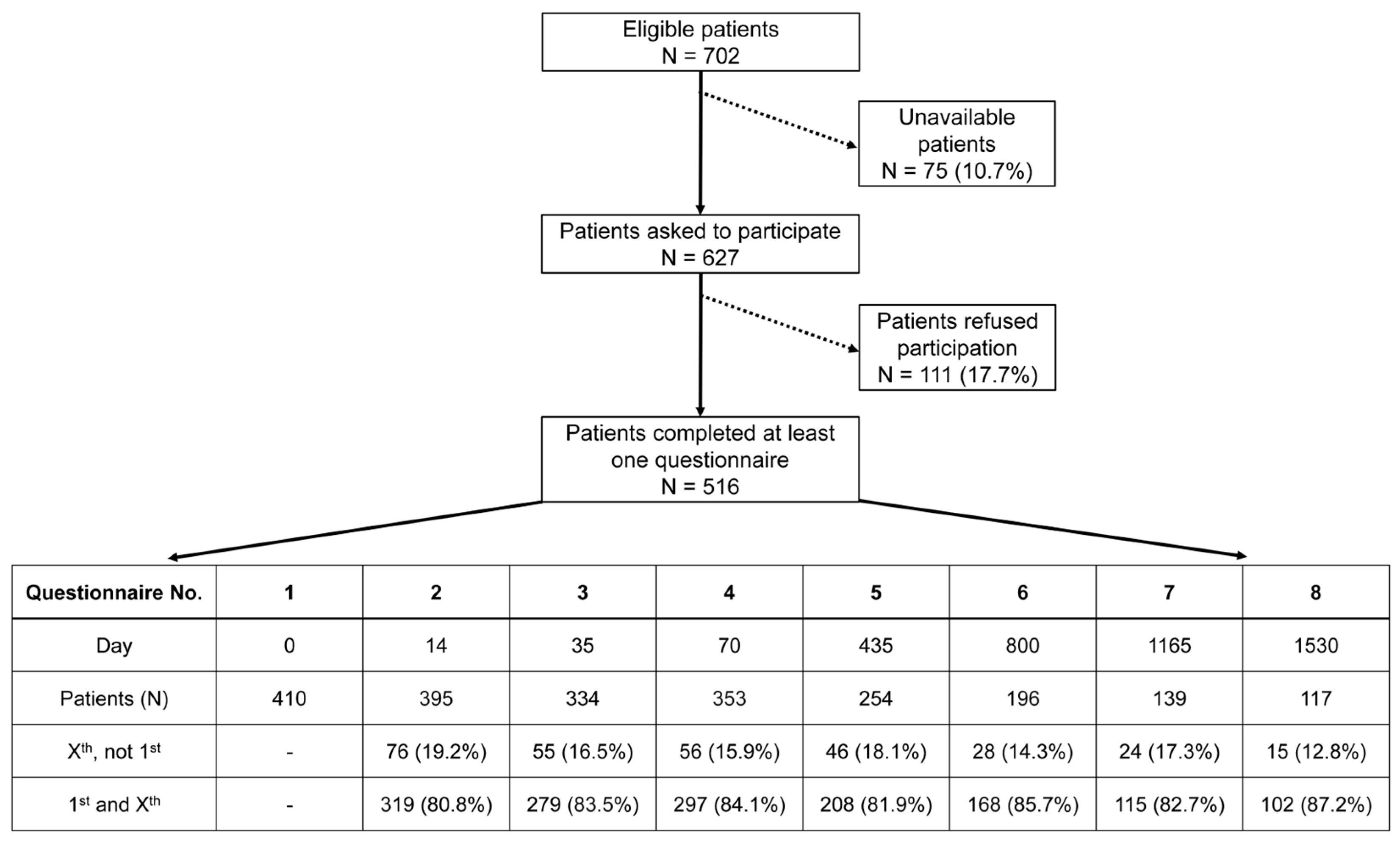
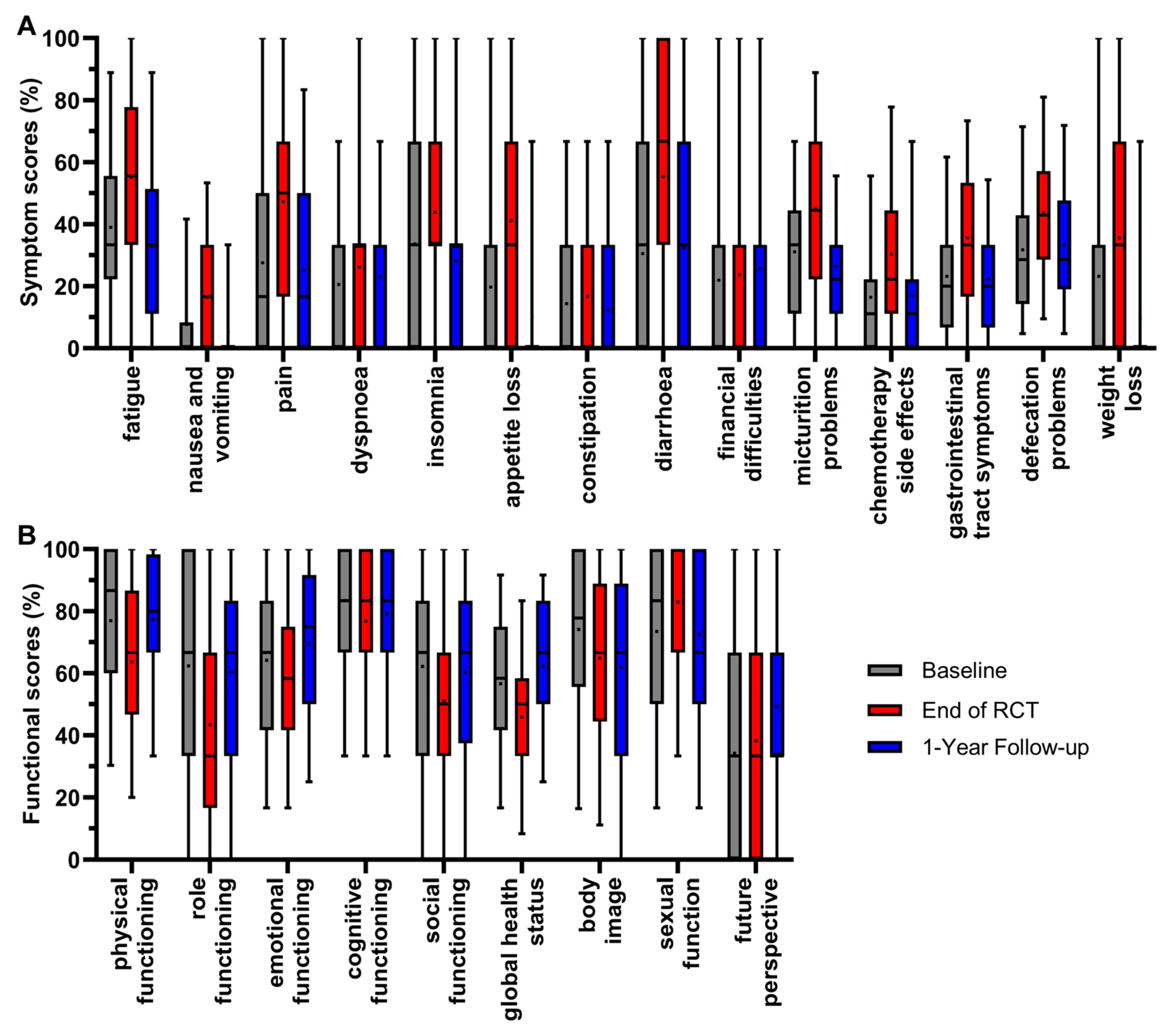
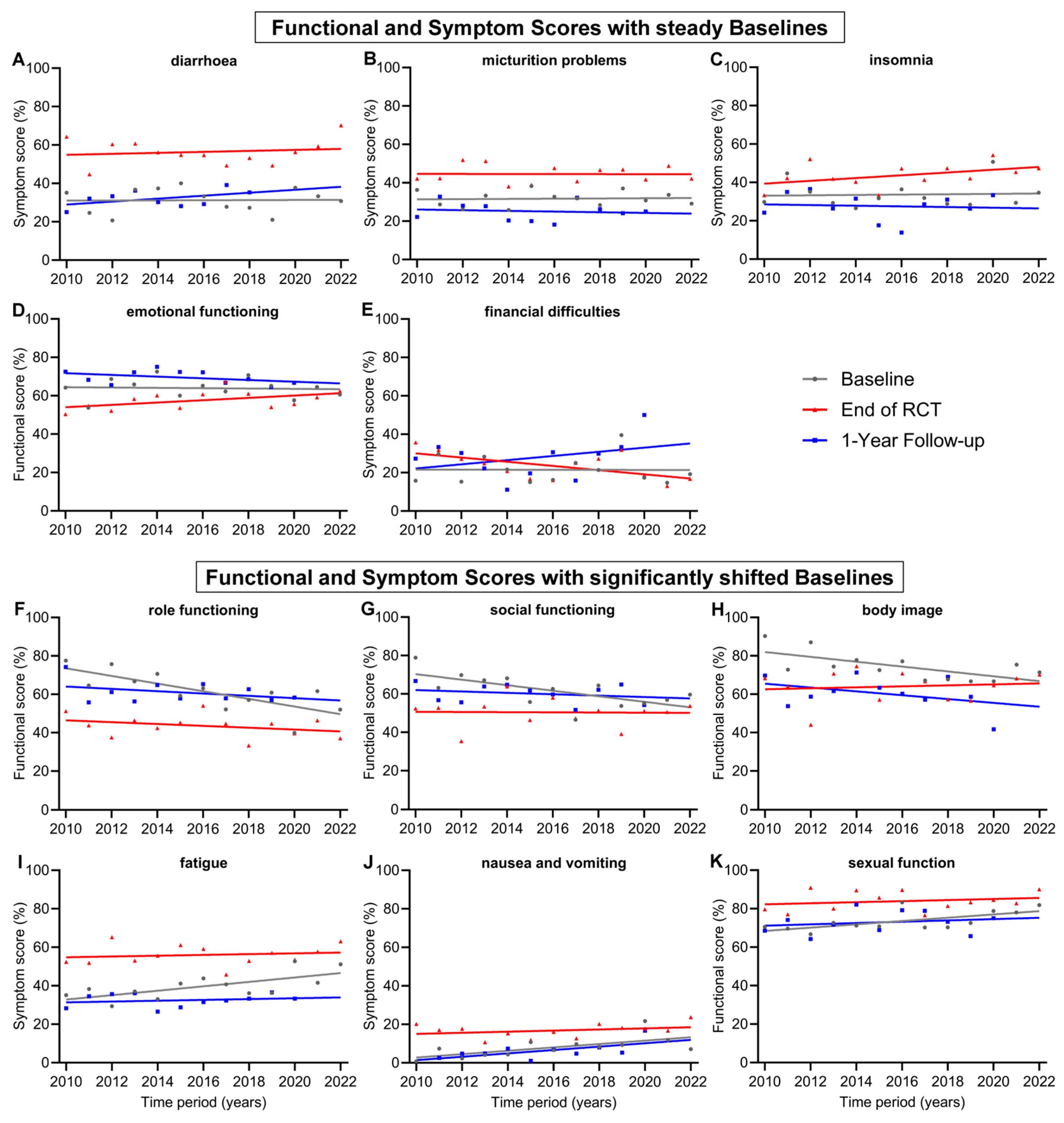
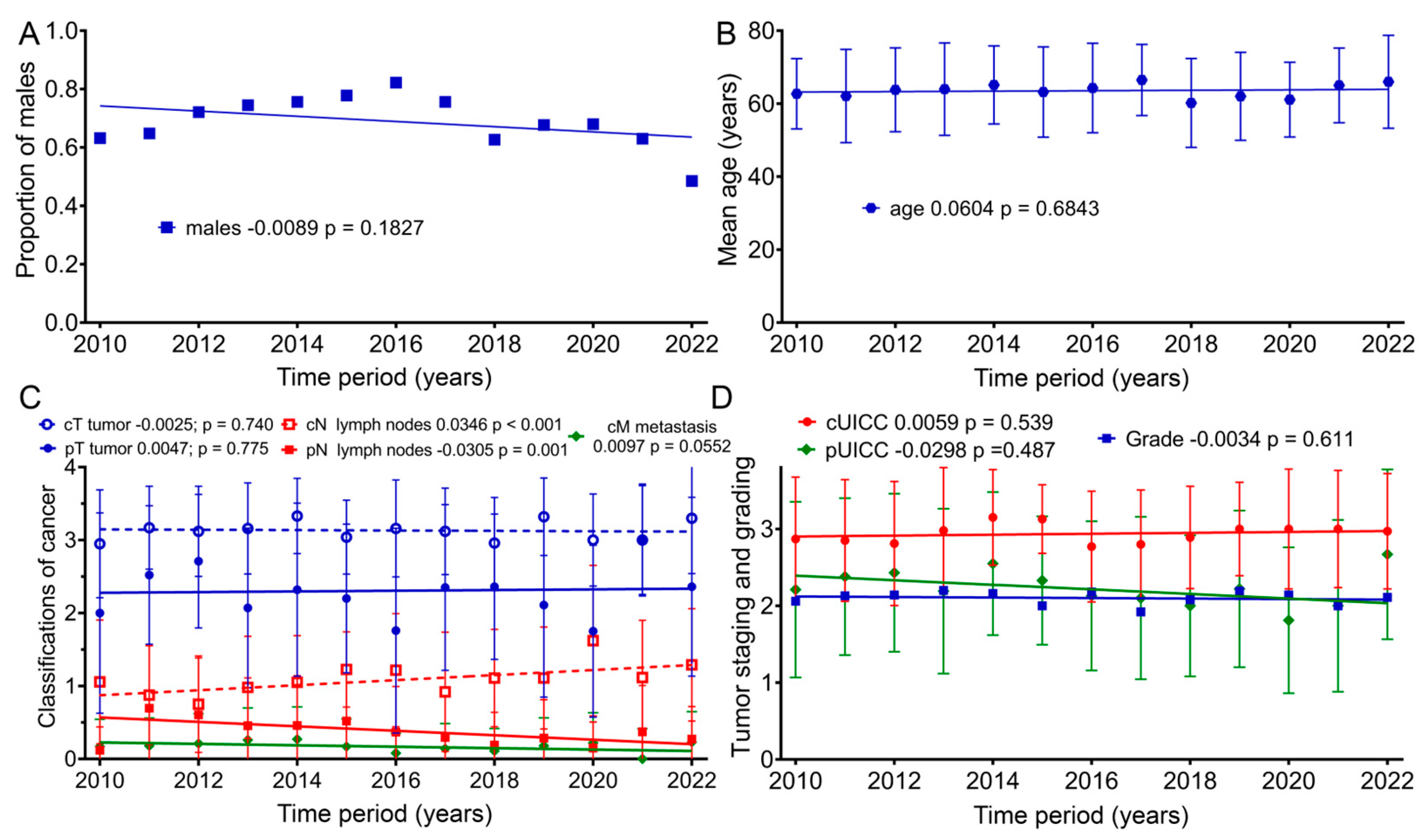
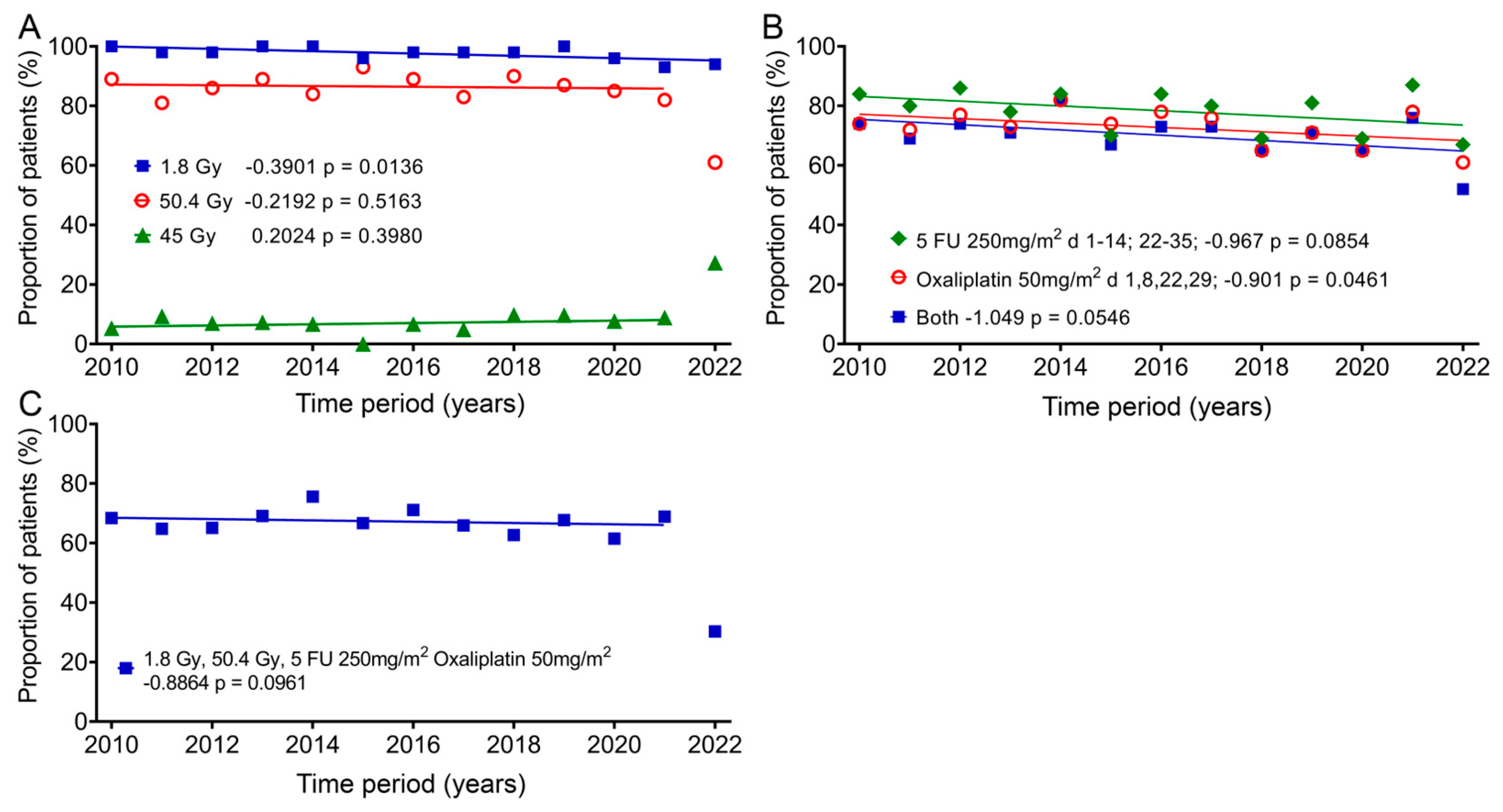
| 2010 | 2011 | 2012 | 2013 | 2014 | 2015 | 2016 | 2017 | 2018 | 2019 | 2020 | 2021 | 2022 | Total | ||
|---|---|---|---|---|---|---|---|---|---|---|---|---|---|---|---|
| Patients N (%) | 20 (4) | 54 (10) | 43 (8) | 55 (11) | 45 (9) | 27 (5) | 45 (9) | 41 (8) | 51 (10) | 31(6) | 25 (5) | 46 (9) | 33 (6) | 516 | |
| Mean age (years) | 62.7 | 62.1 | 63.8 | 64.0 | 65.1 | 63.2 | 64.3 | 66.5 | 60.2 | 62.0 | 61.1 | 65.0 | 66.0 | 63.6 | |
| Age range (years) | 46–76 | 23–85 | 32–81 | 23–85 | 38–86 | 38–86 | 31–87 | 50–90 | 36–80 | 15–82 | 41–79 | 44–88 | 40–93 | 15–93 | |
| Male N (%) | 12 (60) | 35 (65) | 31 (72) | 41 (75) | 34 (76) | 21 (78) | 37 (82) | 31 (76) | 32 (63) | 21 (68) | 17 (68) | 29 (63) | 16 (48) | 357 (69) | |
| Female N (%) | 8 (40) | 19 (35) | 12 (28) | 14 (25) | 11 (24) | 6 (22) | 8 (18) | 10 (24) | 19 (37) | 10 (32) | 8 (32) | 17 (37) | 17 (52) | 159 (31) | |
| TNM Staging N (%) | |||||||||||||||
| cT | 1 | 0 (0) | 0 (0) | 0 (0) | 1 (2) | 0 (0) | 0 (0) | 1 (2) | 0 (0) | 3 (6) | 0 (0) | 0 (0) | 2 (4) | 1 (3) | 8 (2) |
| 2 | 6 (30) | 5 (9) | 6 (14) | 4 (7) | 1 (2) | 3 (11) | 4 (9) | 5 (12) | 2 (4) | 1 (3) | 5 (20) | 5 (11) | 3 (9) | 50 (10) | |
| 3 | 9 (45) | 35 (65) | 26 (60) | 35 (64) | 28 (62) | 20 (74) | 27 (60) | 26 (63) | 40 (78) | 19 (61) | 15 (60) | 26 (57) | 14 (42) | 320 (62) | |
| 4 | 5 (25) | 14 (26) | 11 (26) | 15 (27) | 16 (36) | 4 (15) | 13 (29) | 10 (24) | 6 (12) | 11 (35) | 5 (20) | 13 (28) | 15 (45) | 138 (27) | |
| pT | 0 | 4 (20) | 3 (6) | 1 (2) | 6 (11) | 5 (11) | 3 (11) | 13 (29) | 3 (7) | 4 (8) | 5 (16) | 6 (24) | 0 (0) | 3 (9) | 56 (11) |
| 1 | 1 (5) | 2 (4) | 3 (7) | 5 (9) | 2 (4) | 2 (7) | 2 (4) | 4 (10) | 2 (4) | 4 (13) | 2 (8) | 4 (9) | 0 (0) | 33 (6) | |
| 2 | 6 (30) | 13 (24) | 8 (19) | 15 (27) | 11 (24) | 7 (26) | 6 (13) | 10 (24) | 13 (25) | 4 (13) | 7 (28) | 9 (20) | 5 (15) | 114 (22) | |
| 3 | 3 (15) | 24 (44) | 20 (47) | 16 (29) | 14 (31) | 13 (48) | 15 (33) | 12 (29) | 21 (41) | 13 (42) | 7 (28) | 22 (48) | 10 (30) | 190 (37) | |
| 4 | 3 (15) | 4 (7) | 6 (14) | 2 (4) | 5 (11) | 0 (0) | 2 (4) | 5 (12) | 2 (4) | 2 (6) | 0 (0) | 4 (9) | 2 (6) | 37 (7) | |
| Unknown | 3 (15) | 8 (15) | 5 (12) | 11 (20) | 8 (18) | 2 (7) | 7 (16) | 7 (17) | 9 (18) | 3 (10) | 3 (12) | 7 (15) | 13 (39) | 86 (17) | |
| cN | 0 | 6 (30) | 12 (22) | 12 (28) | 13 (24) | 7 (16) | 1 (4) | 8 (18) | 14 (34) | 8 (16) | 5 (16) | 4 (16) | 11 (24) | 6 (18) | 107 (21) |
| 1 | 5 (25) | 21 (39) | 16 (37) | 26 (47) | 23 (51) | 15 (56) | 13 (29) | 12 (29) | 25 (49) | 12 (39) | 10 (40) | 16 (35) | 11 (33) | 205 (40) | |
| 2 | 7 (35) | 7 (13) | 4 (9) | 12 (22) | 9 (20) | 6 (22) | 16 (36) | 11 (27) | 13 (25) | 11 (35) | 7 (28) | 16 (35) | 15 (45) | 134 (26) | |
| 3 | 0 (0) | 0 (0) | 0 (0) | 0 (0) | 0 (0) | 0 (0) | 0 (0) | 0 (0) | 0 (0) | 0 (0) | 0 (0) | 0 (0) | 0 (0) | 0 (0) | |
| Unknown | 2 (10) | 14 (26) | 11 (26) | 4 (7) | 6 (13) | 5 (19) | 8 (18) | 4 (10) | 5 (10) | 3 (10) | 4 (16) | 3 (7) | 1 (3) | 70 (14) | |
| pN | 0 | 15 (75) | 26 (48) | 22 (51) | 28 (51) | 24 (53) | 14 (52) | 27 (60) | 26 (63) | 35 (69) | 21 (68) | 18 (72) | 26 (57) | 13 (39) | 295 (57) |
| 1 | 2 (10) | 8 (15) | 9 (21) | 12 (22) | 9 (20) | 9 (33) | 8 (18) | 6 (15) | 6 (12) | 6 (19) | 4 (16) | 8 (17) | 7 (21) | 94 (18) | |
| 2 | 0 (0) | 12 (22) | 7 (16) | 4 (7) | 4 (9) | 2 (7) | 3 (7) | 2 (5) | 1 (2) | 1 (3) | 0 (0) | 3 (7) | 0 (0) | 39 (8) | |
| 3 | 0 (0) | 0 (0) | 0 (0) | 0 (0) | 0 (0) | 0 (0) | 0 (0) | 0 (0) | 0 (0) | 0 (0) | 0 (0) | 0 (0) | 0 (0) | 0 (0) | |
| Unknown | 3 (15) | 8 (15) | 5 (12) | 11 (20) | 8 (18) | 2 (7) | 7 (16) | 7 (17) | 9 (18) | 3 (10) | 3 (12) | 9 (20) | 13 (39) | 88 (17) | |
| cM | 0 | 15 (75) | 33 (61) | 26 (60) | 37 (67) | 30 (67) | 19 (70) | 35 (78) | 31 (76) | 42 (82) | 23 (74) | 18 (72) | 35 (76) | 25 (76) | 369 (72) |
| 1 | 3 (15) | 7 (13) | 7 (16) | 13 (24) | 11 (24) | 4 (15) | 3 (7) | 5 (12) | 5 (10) | 5 (16) | 6 (24) | 10 (22) | 7 (21) | 86 (17) | |
| Unknown | 2 (10) | 14 (26) | 10 (23) | 5 (9) | 4 (9) | 4 (15) | 7 (16) | 5 (12) | 4 (8) | 3 (10) | 1 (4) | 1 (2) | 1 (3) | 61 (12) | |
| UICC Staging N (%) | |||||||||||||||
| c | I | 1 (5) | 2 (4) | 2 (5) | 3 (5) | 0 (0) | 0 (0) | 3 (7) | 1 (2) | 3 (6) | 0 (0) | 2 (8) | 2 (4) | 2 (6) | 21 (4) |
| II | 3 (15) | 10 (19) | 8 (19) | 8 (15) | 5 (11) | 1 (4) | 5 (11) | 10 (24) | 4 (8) | 5 (16) | 1 (4) | 7 (15) | 3 (9) | 70 (14) | |
| III | 8 (40) | 20 (37) | 16 (37) | 25 (45) | 23 (51) | 18 (67) | 24 (53) | 19 (46) | 34 (67) | 17 (55) | 15 (60) | 24 (52) | 19 (58) | 262 (51) | |
| IV | 3 (15) | 8 (15) | 6 (14) | 13 (24) | 11 (24) | 4 (15) | 3 (7) | 5 (12) | 5 (10) | 5 (16) | 5 (20) | 10 (22) | 6 (18) | 84 (16) | |
| Unknown | 5 (25) | 14 (26) | 11 (26) | 6 (11) | 6 (13) | 4 (15) | 10 (22) | 6 (15) | 5 (10) | 4 (13) | 2 (8) | 3 (7) | 3 (9) | 79 (15) | |
| p | I | 5 (25) | 10 (19) | 8 (19) | 13 (24) | 4 (9) | 4 (15) | 8 (18) | 12 (29) | 13 (25) | 6 (19) | 8 (32) | 8 (17) | 2 (6) | 101 (20) |
| II | 4 (20) | 13 (24) | 12 (28) | 8 (15) | 10 (22) | 7 (26) | 7 (16) | 8 (20) | 15 (29) | 10 (32) | 4 (16) | 12 (26) | 4 (12) | 114 (22) | |
| III | 2 (10) | 12 (22) | 10 (23) | 10 (18) | 10 (22) | 9 (33) | 7 (16) | 7 (17) | 7 (14) | 3 (10) | 3 (12) | 6 (13) | 2 (6) | 88 (17) | |
| IV | 3 (15) | 7 (13) | 7 (16) | 5 (9) | 5 (11) | 1 (4) | 2 (4) | 4 (10) | 3 (6) | 4 (13) | 1 (4) | 10 (22) | 4 (12) | 56 (11) | |
| Unknown | 6 (30) | 12 (22) | 6 (14) | 19 (35) | 16 (36) | 6 (22) | 21 (47) | 10 (24) | 13 (25) | 8 (26) | 9 (36) | 10 (22) | 21 (64) | 157 (30) | |
| Grading N (%) | |||||||||||||||
| 1 | 2 (10) | 1 (2) | 1 (2) | 1 (2) | 2 (4) | 1 (4) | 0 (0) | 4 (10) | 3 (6) | 1 (3) | 0 (0) | 2 (4) | 2 (6) | 20 (4) | |
| 2 | 12 (60) | 40 (74) | 34 (79) | 37 (67) | 32 (71) | 24 (89) | 32 (71) | 32 (78) | 40 (78) | 20 (65) | 19 (76) | 36 (78) | 22 (67) | 380 (74) | |
| 3 | 3 (15) | 7 (13) | 7 (16) | 11 (20) | 9 (20) | 1 (4) | 7 (16) | 1 (2) | 7 (14) | 6 (19) | 4 (16) | 6 (13) | 5 (15) | 74 (14) | |
| 4 | 0 (0) | 0 (0) | 0 (0) | 0 (0) | 0 (0) | 0 (0) | 0 (0) | 0 (0) | 0 (0) | 0 (0) | 0 (0) | 0 (0) | 0 (0) | 0 (0) | |
| Unknown | 3 (15) | 6 (11) | 1 (2) | 6 (11) | 2 (4) | 1 (4) | 6 (13) | 4 (10) | 1 (2) | 4 (13) | 2 (8) | 2 (4) | 4 (12) | 42 (8) | |
Disclaimer/Publisher’s Note: The statements, opinions and data contained in all publications are solely those of the individual author(s) and contributor(s) and not of MDPI and/or the editor(s). MDPI and/or the editor(s) disclaim responsibility for any injury to people or property resulting from any ideas, methods, instructions or products referred to in the content. |
© 2024 by the authors. Licensee MDPI, Basel, Switzerland. This article is an open access article distributed under the terms and conditions of the Creative Commons Attribution (CC BY) license (https://creativecommons.org/licenses/by/4.0/).
Share and Cite
Doelz, A.; Blasko, D.; Schweizer, C.; Fitz, T.; Kallies, A.; Fietkau, R.; Distel, L. Change in Quality of Life in Patients with Advanced Rectal Cancer Between 2010 and 2022. Healthcare 2024, 12, 2108. https://doi.org/10.3390/healthcare12212108
Doelz A, Blasko D, Schweizer C, Fitz T, Kallies A, Fietkau R, Distel L. Change in Quality of Life in Patients with Advanced Rectal Cancer Between 2010 and 2022. Healthcare. 2024; 12(21):2108. https://doi.org/10.3390/healthcare12212108
Chicago/Turabian StyleDoelz, Ailina, Daniel Blasko, Claudia Schweizer, Tim Fitz, Annett Kallies, Rainer Fietkau, and Luitpold Distel. 2024. "Change in Quality of Life in Patients with Advanced Rectal Cancer Between 2010 and 2022" Healthcare 12, no. 21: 2108. https://doi.org/10.3390/healthcare12212108
APA StyleDoelz, A., Blasko, D., Schweizer, C., Fitz, T., Kallies, A., Fietkau, R., & Distel, L. (2024). Change in Quality of Life in Patients with Advanced Rectal Cancer Between 2010 and 2022. Healthcare, 12(21), 2108. https://doi.org/10.3390/healthcare12212108







